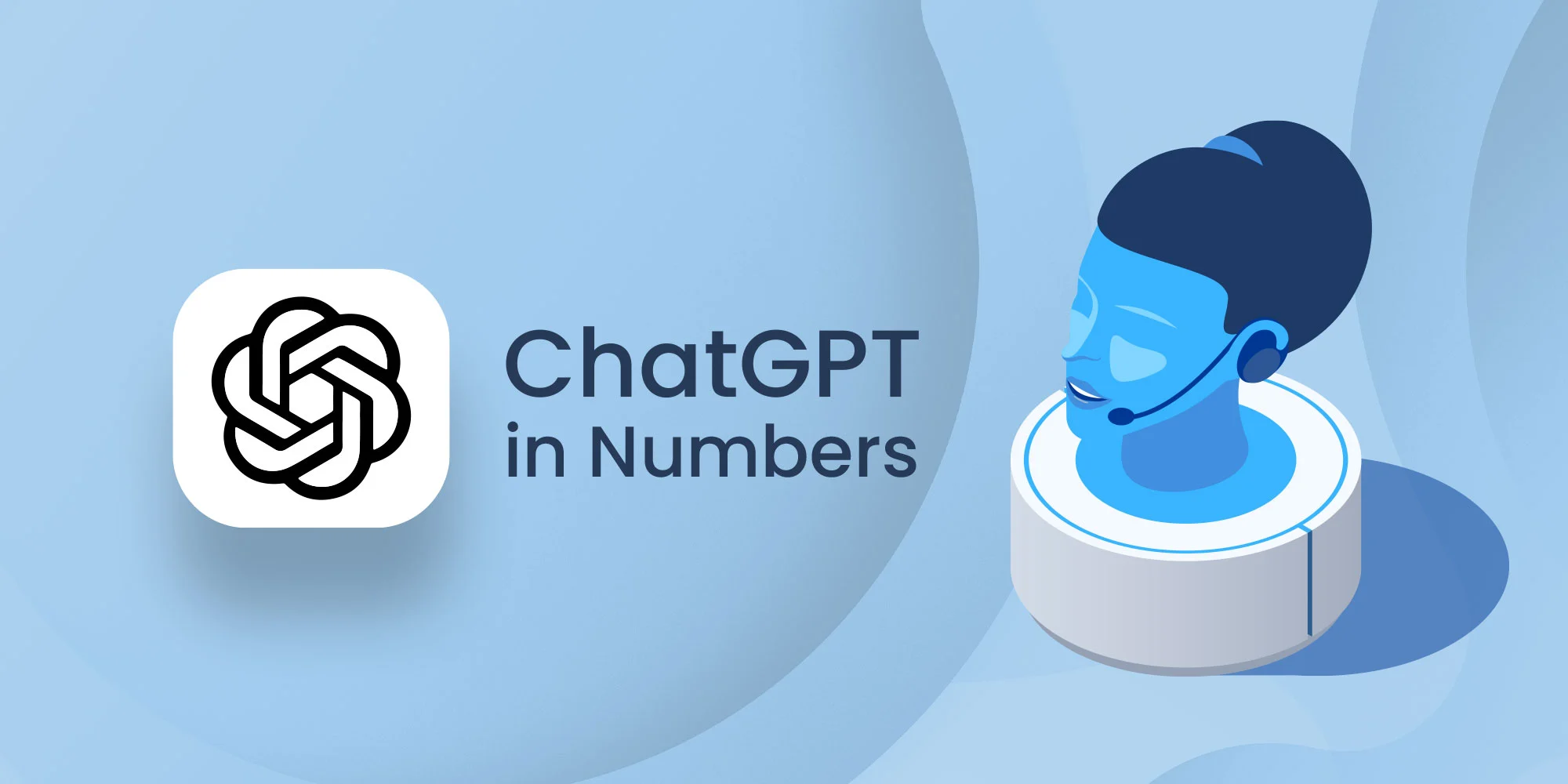Published in InvGate.
Rest assured that with the ChatGPT statistics you’re about to read, you’ll confirm that the popular chatbot from OpenAI is just the beginning of something bigger. Since its launch in November 2022, ChatGPT has broken unexpected records. For example, it reached 100 million active users in January, just two months after its release, making it the fastest-growing consumer app in history.
This chatbot has revolutionized the field of AI by using deep learning techniques to generate human-like text and answer a wide range of questions with high accuracy. The versatility of the responses goes from the generation of code to the creation of memes. One of its most common uses is for customer service, though ChatGPT can also be helpful for IT support.
But what makes ChatGPT so disruptive? In this article, you’ll discover some of the most significant ChatGPT statistics and facts that will help you understand how far AI has come. Read on to find out!
What is ChatGPT?
Developed by OpenAI, ChatGPT is an innovative artificial intelligence chatbot based on the open-source GPT-3 natural language processing (NLP) model.
The chatbot can understand what users say, anticipate their needs, and respond accurately. It interacts conversationally, so users can feel like they are talking to a real person.
50 ChatGPT statistics and facts you need to know
With the rising popularity of ChatGPT, we began to wonder about the numbers behind such a massive phenomenon. So, we started digging, and here’s everything we found out.
ChatGPT history
1. OpenAI has been developing GPT (Generative Pre-Train) since 2018.
2. GPT-1 and GPT-2 laid the foundations for GPT-3.
3. GPT-1 was trained with BooksCorpus dataset (5GB), whose primary focus was language understanding.
4. On Valentine’s Day 2019, GPT-2 was launched with the slogan “too dangerous to release.” It was trained with Reddit articles with over 3 likes (40GB). The training cost was $43,000.
5. Later, GPT-2 was used to generate music in MuseNet and JukeBox.
6. In June 2020, GPT-3 was released, which was trained by a much more comprehensive dataset.
7. Some of the applications that were developed based on GPT-3 are:
- DALL-E: creating images from text.
- CLIP: connecting text and images.
- Whisper: multi-lingual voice-to-text.
- ChatGPT: chatbot, article writer, code writer.
ChatGPT general facts
8. OpenAI’s GPT-4 is the largest language model created to date. ChatGPT-4 was released on March 14, 2023.
9. It has 175 billion parameters and receives 10 million queries per day.
10. It was trained on a massive corpus of text data, around 570GB of datasets, including web pages, books, and other sources.
11. GPT-3 has been fine-tuned for a variety of language tasks, such as translation, summarization, and question-answering.
12. It can generate human-like text, including poems, stories, and even code.
13. The response time of ChatGPT is typically less than a second, making it well-suited for real-time conversations.
14. ChatGPT has been integrated into a variety of platforms and applications, including websites, messaging apps, virtual assistants, and other AI applications.
15. Some experts have called GPT-3 a major step in developing artificial intelligence.
16. GPT-3 has been praised for its ability to understand the context and produce relevant responses.
17. It has been shown to outperform previous language models and even humans on certain language tasks.
18. GPT-3 has also been criticized for its lack of common sense knowledge and susceptibility to producing biased or misleading responses.
19. OpenAI has made GPT-3 available through an API, allowing developers to create their own AI applications.

ChatGPT performance
20. An area where ChatGPT excels is in the generation of text. The model can generate coherent and fluent text on a wide range of topics, making it a popular choice for applications such as chatbots, language translation, and content generation.
21. The text generated by ChatGPT is often difficult to distinguish from text written by a human, as demonstrated by its performance on the DALL-E 2.0 test, where it generated high-quality images from textual descriptions.
22. ChatGPT’s performance is also influenced by the amount of training data it has been exposed to. The more data a language model has been trained on, the more information it has available to generate accurate and relevant responses.
23. OpenAI has reported that the model’s performance improves significantly when it is fine-tuned on specific domains or tasks, demonstrating flexibility and adaptability.
ChatGPT limitations
24. One of the biggest challenges is its computational requirements. The model requires significant computational resources to run, making it challenging to deploy in real-world applications.
25. Despite its large size and high accuracy, ChatGPT still makes mistakes and can generate biased or inaccurate responses, particularly when the model has not been fine-tuned on specific domains or tasks.
26. ChatGPT cannot access the internet or external links.
27. ChatGPT’s knowledge is limited to its training data, which has the cutoff year of 2021.
ChatGPT statistics: research warns of risk of malicious use
28. According to research released by BlackBerry, 51% of IT decision-makers believe a successful cyberattack will be credited to ChatGPT within the year.
59. 71% of those surveyed figure that nation-state actors are already using the technology for “malicious” purposes.
30. Regarding how exactly ChatGPT will be used to help foster cyberattacks, 53% of people said it would help hackers create more believable phishing emails.
31. 49% of respondents pointed to its ability to help hackers improve their coding abilities.
32. The survey also revealed that 49% of people believe ChatGPT will be used to spread misinformation and disinformation.
33. 48% of those surveyed think it could be used to craft entirely new malware strains.
34. 46% of respondents said ChatGPT could help improve existing attacks.
35. The same research also revealed that 95% believe governments are responsible for regulating advanced technologies, such as ChatGPT.
ChatGPT statistics: costs
36. ChatGPT is free for users during the research phase while the company gathers feedback.
37. For developers who want to incorporate this tool into other software, the cost is around a penny for 20,000 words of text and approximately 2 cents for images.
38. The GPT-3 AI model reportedly cost OpenAI $12 million for a single training run.
39. Tom Goldstein, an AI ML Professor at Maryland University, has estimated the daily cost of running ChatGPT to be approximately $100,000 and the monthly cost to be $3 million. His estimates are based on Azure Cloud costs (server infrastructure on which ChatGPT runs).
40. OpenAI has recently launched a pilot subscription price of $20. It is invite-only, promises access even during peak times, and provides faster responses and priority access to new features and improvements.
OpenAI background and investments
41. OpenAI was founded in San Francisco in 2015 by Carlos Virella, Elon Musk, Greg Brockman, Ilya Sutskever, James Greene, Sam Altman, and Wojciech Zaremba.
42. The startup has successfully attracted a series of high-profile investors.
43. After the launch of ChatGPT, OpenAI is valued at $29 billion.
44. Microsoft invested $10 billion recently. It represents the third investment that the company founded by Bill Gates made. It plowed $1 billion into OpenAI in 2019 and reinvested in 2021.
45. OpenAI ranks among the most funded machine-learning startup firms in the world, with funding of over 1 billion U.S. dollars as of January 2023.
46. In a recent pitch to investors, OpenAI expects $200 million in revenue this year and $1 billion by 2024.
47. Companies in the technology and education sectors are most likely to take advantage of OpenAI’s solutions. At the same time, business services, manufacturing, and finance are also high on the list of industries utilizing artificial intelligence in their business processes.
ChatGPT statistics: users
48. ChatGPT gained 1 million users in under a week.
49. The chatbot accumulated 57 million monthly active users in its first month of availability.
50. It surpassed 100 million active users in January.
Key takeaways
ChatGPT has swept the world, and there are reasons why it has happened:
- With its 175 billion parameters, it has converted into the most prominent language model.
- It has demonstrated impressive performance on various NLP tasks and applications.
- Its large size and diverse training data allow it to generate high-quality text and answer a wide range of questions with high accuracy.
However, the model’s computational requirements and potential for bias and error are essential considerations when deploying it in real-world applications. Moreover, cybercriminals could use it to carry out successful attacks.
But let’s face it, with its pros and cons, ChatGPT has a promising future ahead. The investment it recently received from Microsoft and the launch of the subscription pilot demonstrate it.

